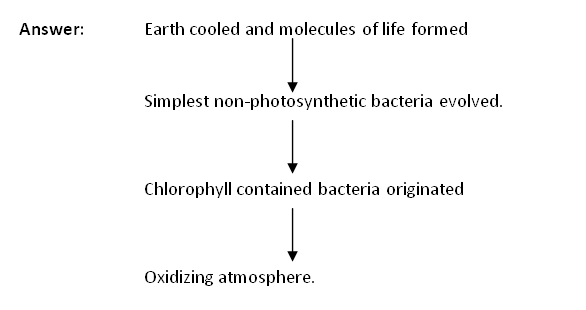Here is free NIOS Environmental Science (333) TMA 2020-2021. Also, download a free PDF soft copy of Solved Environment Science Assignment (TMA) for class 12.
NIOS Environmental Science (333) solved Tutor Marked Assignment 2020-2021 for Senior Secondary.
Table of Contents
Board: NIOS.
Class: Senior Secondary.
Subject: Environmental Science (333).
Year/Session: 2020-2021.
Medium: English.
Environmental Science ( 333) Solved TMA 2020-21
1.Answer any one of the following questions in about 40-60 words.
Given below are some of the important facts in the origin and evolution of life on earth. Arrange them in the correct sequence.
(i) Oxidizing atmosphere.
(ii) Simplest non-photosynthetic bacteria evolved.
(iii) Earth cooled and molecules of life formed.
(iv) Chlorophyll contained bacteria originated.

2.Answer any one of the following questions in about 40-60 words.
(b) Your neighbour wants to start aquaculture as a profession/occupation. To encourage him, tell him about any four of its advantages.
Answer: Advantages of aquaculture:
(1) Ecological efficiency is high. 2 kg. of grains are required to add 1 kg live weight.
(2) High yield in small volume of water.
(3) Improved qualities of fish obtained by selection and breeding and genetic engineering.
(4) High profit.
You may also like:
NIOS English(302) Solved TMA
NIOS Bus.Studies Solved TMA
NIOS Home Science Solved TMA
3.Answer any one of the following question in about 40-60 words.
(a) Rural and urban settlements differ from each other in many ways. Write difference between rural and urban settlements with reference to:
(i) Occupation.
(ii) Population density
Answer: Differences between rural and urban settlement:
| Factors | Rural | Urban |
|---|---|---|
| Occupation | Agriculture, Cultivators and their families are in majority.Few are engaged in non agriculture activity. | Mostly industrial workers,traders,professionals and working in office |
| Population Density | Comparatively lower density of population. | Large population density. |
4.Answer any one of the following questions in about 100 to 150 words.
(b) A dairy farm owner gives harmonal injection to his livestocks (Milching animals) in order to facilitate to increase milk production. Name the chemical injected and also mention its adverse effects on the livestocks.
Answer: A dairy farm owner inject Oxytocin (Hormone) to his livestock to increase milk production.
Adverse affect of hormonal injection:
• Hormone increases the amount of milk but their udder enlarges abnormally, so much so that the cows have difficulty in movement and they develop an abnormal gait.
• It also affects their normal physiology of reproduction.
• Oxytocin causes milk ejection from mammary glands in nursing mothers. This hormone also causes uterine contraction, so the injection of this hormone for milk release can cause pain and discomfort to the animal.
5. Answer any one of the following questions in about 100-150 words.
(b) What is the importance of environmental ethics in our lives? Explain in four sentences.
Answer: Environmental ethics is that part of philosophy that considers the ethical relationship between human beings and the natural environment. Equilibrium is maintained in natural ecosystems between different components through various processes including assimilation and recycling. But over-exploitation of resources by the growing human population has upset the natural balance. The use of technology and economic growth have led to ecological problems. The economic progress has been achieved at an enormous cost to the environment as manifested by growing pollution, loss of biodiversity, and a critical shortage of basic resources. The role of ethics becomes important, therefore, as it helps to assess strengths and weaknesses of developmental activities such as deforestation, building a dam, mining, draining a wetland, etc
6.Prepare any one project of the following projects given below.
(b) Go out to a nearby field and collect some leguminous plants. Observe their roots carefully. Write your observations and draw the diagram of these roots. Prepare a report regarding the cause of the development of nodules as well as their significance. Draw a simplified flow chart of biochemical steps involved in this process.
Answer: The root nodules in legume plants are produced due to infection of bacteria Rhizobium. This free-living soil bacteria usually grow near the roots of the legumes and is unable to fix nitrogen in a free condition. It fixes nitrogen only when it enters into the root and is present inside root nodules. The roots of leguminous plants secrete some special types of lectins. The plant lectin of a given species can interact with the polysaccharides of only a particular plant. The actual site, where the interaction takes place leading to the formation of nodules lies between the root tips and young root hair. The bacteria enter into the host through young root hairs. Prior to entry, it secretes some hormone-like substances which cause deformation and curling of young root hairs. First, a tubular infection thread is formed in the root hair cell and the bacteria enter into this thread, a new cell wall is formed which separates the bacteria from the contents of the host cells. The tubular infection thread contains mucopolysaccharides in which the bacteria get embedded
and start multiplying. The infection threads containing bacteria and from root hair cell reaches to the cells of the inner layers of cortex where the bacteria are released. These bacterial cells induce the cortical cells to multiply which results in the formation of nodules on the surface of the roots.

Reference: https://gcwgandhinagar.com/ ,NIOS Books,NCERT books.
Please Share:






